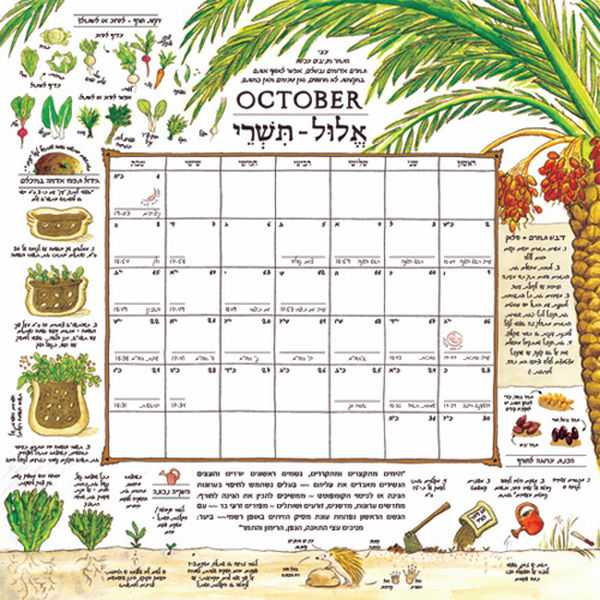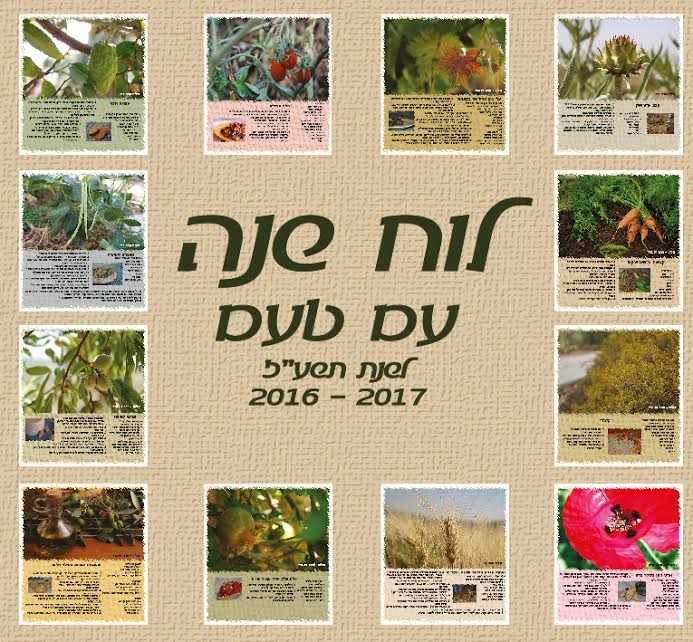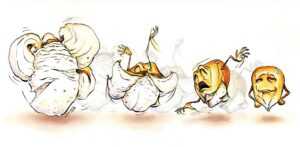The New Year is approaching, abounding with special treats!
This week we begin distributing Ilana and Davidi’s Luach Shana BaGina
It is a Hebrew/English/agricultural/pictorial calendar, unique and beautifully made by Ilana and Davidi, old friends who are gardeners and collectors, cooks and talented dreamers. The calendar walks you through the year, describing in pictures and words the annual cycle in your home garden and surrounding nature.
Further details and a sneak peak of the calendar are available at their website.
Order the calendars via our order system (under the “Chubeza Vegetables” category). Judging from last year, make your order fast before these beauties disappear!
____________________________
Another calendar we are happy to share with you for the second year in a row is “עם טעם” (“Tasteful”), a beautiful calendar with photos of the fruit of Israel alongside healthy, tasty vegan recipes, in sequence with the produce of the season.
 This year, the calendar producers are introducing a special new product: a children’s cookbook with 10 healthy and vegan recipes woven into a lovely story about a girl named Chaya and her family. The very detailed and simple explanations, enhanced by charming illustrations, make cooking easy and fun for the kids.
This year, the calendar producers are introducing a special new product: a children’s cookbook with 10 healthy and vegan recipes woven into a lovely story about a girl named Chaya and her family. The very detailed and simple explanations, enhanced by charming illustrations, make cooking easy and fun for the kids.
The calendar and book are a combined effort by several very gifted artists, led by the exceptionally talented sisters Dora and Mara Zinnigrad, both friends of Chubeza from a young age. These two were joined by Bat Chen, Tamar and Ma’ayan, and together they hope to help more people transform their kitchens to happier and healthier environments, proving that healthy cooking is simple and fun for the whole family.
Dora and her friends are funding this project through Jumpstarter, and this is the link to their project. Take a look and lend your support!
____________________________
 Reminder: only two weeks remain for the incredible August sale of Arik and Asaf, producers (grinders) of the high-quality “Minchat Ha’Aretz” flour:
Wheat flour (70% whole wheat) – 8 NIS
Spelt flour (70% whole grain) – only 15 NIS
Whole rye flour – only 12 NIS
Reminder: only two weeks remain for the incredible August sale of Arik and Asaf, producers (grinders) of the high-quality “Minchat Ha’Aretz” flour:
Wheat flour (70% whole wheat) – 8 NIS
Spelt flour (70% whole grain) – only 15 NIS
Whole rye flour – only 12 NIS
Don’t let the summer heat blind you from this super sale! At these prices, your baked goods will be all the tastier! Time to bake some bread and spread it with your homemade pesto………
Bon Appetit!
________________________________
POP GOES THE CORN!
Stop!! Before you’re so overcome with sorrow over the shriveled, hard-as-rock corn in your box this week that you thrust the kernels in a pot to be cooked forever and ever, or crack your crowns while attempting to bite into them, read on for the True Story Behind the Kernels!
Traditionally, the end of each summer heralds the popcorn season. Over the next few weeks, you will be receiving smaller and stiffer corn cobs than usual. Don’t toss them out figuring Chubeza’s crop went bad this week. These are actually rare, delectable treats. It’s popcorn!
In honor of this joyous corn creation, we annually renew The Popcorn Newsletter. Settle back in your chairs and enjoy the show!
Back around 3500 BC in a cave in North America (somewhere central-west of today’s New Mexico), the guys were hanging out together, glued to the TV of the era, the blazing campfire. As the flames danced and brought joy to their hearts, they had to nosh on something. But for reasons that remain shrouded in mystery, they somehow did not polish off everything from their plates. Remains of that late-night-nosh were discovered over 5000 years later by archaeologists in 1948, in what became known as world’s oldest popcorn. (It still looked quite crunchy and yummy, but a tad too stale to nibble on.)
The popcorn is indeed a special species of corn. They were seeded in March along with the first round of corn, but after the plants grew dark red-bearded cobs, we cut off their water and allowed the cobs, smaller than the sweet corn variety, to fully mature and dry on the stalk. Last week we picked the dry, hard cobs and stored them in our warehouse for further drying and hardening. How wonderful to munch on food that bears a history of thousands of years of noshing!
Popcorn comes in many colors and forms. Here are a few of them:
An especially cute type is strawberry popcorn, which looks like this:
Native Americans used popcorn even before they discovered the corn we know and love so well. They probably fell onto popcorn by chance, as some random kernel rolled into the fire and suddenly popped. This surely led to attempts to reenact the wonder, and later to make it an institution. In ancient times, they would roast the popcorn by heating the cobs over direct flame or in a pit in the ground filled with sand and heated to a high temperature. The cobs were placed into the pit whole, and the kernels would pop on the cob, wrapped in its sheaf and protected from the sand. Prehistoric cooks also made special utensils to roast this snack, clay pots with feet to place atop the fire.
Primeval Americans used the popcorn not only as nosh. They made soup and beer out of it, and it was used as a decoration in ritual ceremonies, as well as for jewelry and head ornaments. Tlaloc, the Aztec god of rain and fertility, was adorned with popcorn-string necklaces, and the God of Water and Protector of Fishermen would receive an offering of “hailstones” made from popcorn. Europeans who arrived ashore were also welcomed with gifts of popcorn necklaces, and to this day there are those who decorate their Christmas trees with fresh, aromatic popcorn.
One modern, non-conventional popcorn-based attempt—which ultimately failed—was to use popcorn as an ecological, biodegradable substitute for Styrofoam packing material. You must admit that this is a very captivating idea, yet sadly the popcorn’s natural appeal attracted insects and other pests and organisms to the party. The popcorn completely lost its beneficial packing qualities when wet, and was prone to flammability. Alas.
Popcorn, or in its scientific name, Zea mays averta, is a subspecies of flint corn. Flint corn got its name from its hard-as-rock shell, one of the required components for popping. Also required are a proper level of humidity and a high level of starch within the kernel. Due to the kernel’s hard shell, when it’s heated, the moisture locked inside turns to steam and the pressure builds up. The starch inside the kernel gelatinizes and becomes soft and pliable. The pressure continues to mount until reaching the breaking point of the hull: The steam forcefully explodes, exposing the soft starch. The starch expands and dries rapidly to become the dry, crispy, puffy foam we call popcorn.
Some Tips:
– For the foam to dry quickly, place the kernels in a pot in a thin layer to create crispy popcorn that will not reabsorb the moisture from the pot.
– FYI, popped popcorn kernels expand exponentially beyond their original size. Two tablespoons of raw popcorn kernels produce 2 ½ cups of the popped product!
– In its natural form, popcorn is an excellent choice for a healthy snack. Air-popped popcorn is naturally high in dietary fiber, low in calories and fat, and is both sodium and sugar free. This, of course, relates to clean, fresh popcorn, minus the addition of butter and oil, salt or caramel that transform it from a handsome prince to a scary toad.
Storage: Popcorn kernels might look tough, but they won’t stay that way unless you treat them properly. Storing popcorn in the fridge may dry it out or make it too moist to allow popping. Best to keep popcorn kernels in a dry, dark cupboard away from heat, moisture and light.
It is advisable to separate the kernels from cob and store in sealed jar, ceramic container or sealed tin. Here is how you do it:
Making quality popcorn is an art in itself. The quality and quantity of the popping depends on the rate at which the kernels are heated. If heated too quickly, they’ll explode before the starch in the center of the kernel can fully gelatinize, leading to half-popped kernels with hard centers (what was the hull). The tip of the kernel, where it attached to the cob, is more sensitive than the rest of the hull. Heating too slowly will crack the tip and allow steam to escape, preventing the build-up of pressure and the ultimate popping. In the past, making popcorn in a pot was a task that required training, specialization, and great skill. In today’s era of the microwave and automatic popcorn-popper, everything is so much simpler, but still it’s a good idea to put aside a few kernels and try the old-fashioned popping method of yesteryear.
Popping Instructions:
In microwave: Place small quantity of kernels (approximately 2 T) into a paper bag you received in your box (make sure it’s dry and not torn), and fold the edge of bag to seal. (At last: a way to re-use those paper bags!) Set timer for 2-3 minutes, and listen carefully. After a few seconds the kernels will start popping loudly, setting the bag into a lively, throbbing dance. When 3 seconds without any popping have elapsed, remove paper bag from the microwave. Caution! It’s hot. Make a small opening for ventilation; allow steam to escape, and then cool. Add the seasoning of your choice and nosh away.
In a pot: (from the website of Kibbutz Sha’ar Hagolan)
You will need: Popcorn. A pot. Oil.
We all know the black and sooty telltale spots shamefully lining the pots, reminding us of unsuccessful popcorn, or the sad “old maids,” the un-popped kernels that will never receive another chance.
Here’s how to avoid these embarrassing failures, step by step:
The Pot: Use a wide, tall pot so the kernels have room to expand.
The rule is 3 T oil for each ½ – ¾ cup of popcorn. The oil should cover the bottom of the pot and coat each kernel. (You can combine oil and butter, if desired.) Step 1: Pour the oil and wait a bit till it warms up. (Can use one or two kernels to test.) When oil-bubbles form around kernel, it’s time to start. Question: Should we toss the kernels? A: In the beginning of the process, you can give the pan a little shake to arrange the kernels in one layer and for the oil to cover. Step 2: Leave the kernels on medium heat. When you start hearing the first to pop, lower the flame. (Babysitter: Keep an eye on them. This is no time to check your email.) Listen to the sound of the popping kernels. When the popping diminishes, it’s time to turn off the flame. Do not open the pot till you hear the silence of the all-popped popcorn.
Wishing us all a great week of summer,
Alon, Bat Ami, Dror, Yochai and the Chubeza team
________________________________
WHAT’S IN THIS WEEK’S BOXES?
Cucumbers are now in short supply at Chubeza, along with other organic growers at this hot time of year. Unable to purchase any from other growers, we’ve placed either cucumbers or peppers in this week’s boxes. Hopefully this shortage will soon end!
Monday: New Zealand spinach/Swiss chard, coriander/nana mint/ basil, tomatoes, Thai lubia/ lubia/okra, cherry tomatoes, eggplant, Provence pumpkin slice, cucumbers/bell peppers, corn, popcorn, onions.
Large box, in addition: Butternut squash, parsley, leeks/scallions
Wednesday: New Zealand spinach/Swiss chard/basil, coriander/dill, tomatoes, Thai lubia/ lubia/okra, cherry tomatoes, eggplant, butternut squash/potatoes, bell peppers, popcorn, onions, leeks/scallions.
Large box, in addition: Provence pumpkin slice, parsley, corn.
The eggplants are in their high season now, Margie sent me this link – The Simplest Way to Turn an Eggplant into Dinner.
Enjoy!
And there’s more! You can add to your basket a wide, delectable range of additional products from fine small producers: flour, fruits, honey, dates, almonds, garbanzo beans, crackers, probiotic foods, dried fruits and leathers, olive oil, bakery products, apple juice, cider and jams and goat dairy too! You can learn more about each producer on the Chubeza website. On our order system there’s a detailed listing of the products and their cost, you can make an order online now!





